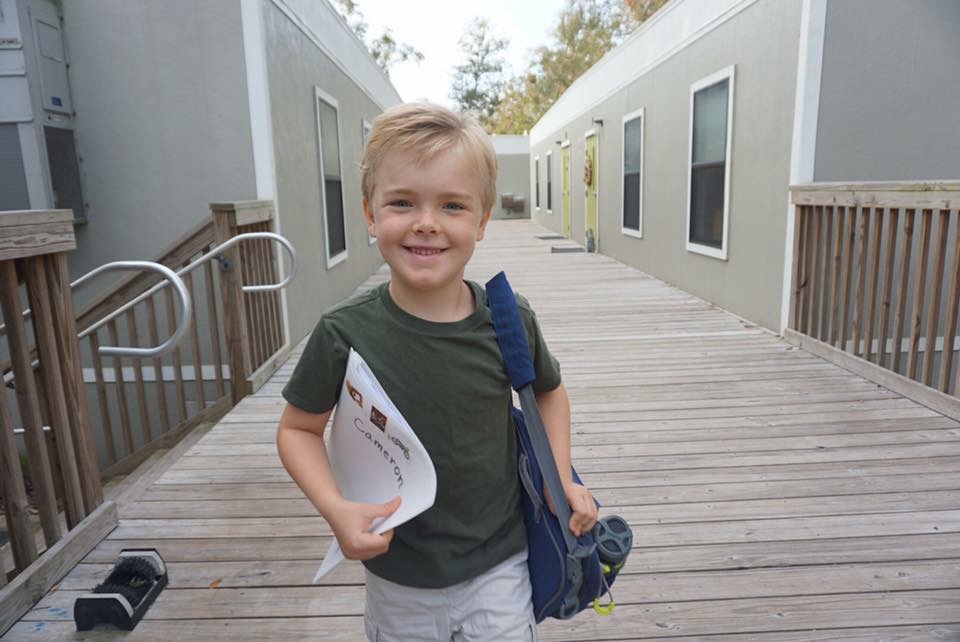
I know I’m not the only one. At a volunteer event a couple weeks ago, three of the four moms confided that their child has a learning disability or developmental difference. I was one of the three.
I don’t have a name to concisely communicate my son’s differences. We’ve tried on labels like sensory processing disorder, childhood anxiety, PANDAS (pediatric autoimmune neuropsychiatric disorders associated with streptococcal infections), ADHD, and high-functioning autism.
The stories and research around those labels are already out there and being discussed in groups like Jax Moms Blog Moms of Special Needs Children on Facebook. And they certainly helped me along the way. But the part I feel like I need to share is the part I had never heard of before — a little known but common gene mutation that I’m still struggling to understand.
Here’s how we found it.
Recognizing the Problem
Our family’s journey started when my son was barely 3 years old. “I think it’s time to go to the pediatrician,” his Montessori teacher said just six weeks into the academic year. She was concerned about my son’s behavior and lack of participation in class.
My knee-jerk reaction was to take offense and withdraw him from the school. He needed a play-based preschool that could handle his energetic spirit, I reasoned. Likewise, the pediatrician deemed the teacher’s concerns overblown and sent me on my way with a recommendation to read The Difficult Child.
Next came the play-based preschool, and then kindergarten at the Waldorf-inspired public charter school. With each new setting, inevitably I would hear the familiar refrain from the teacher in a matter of weeks: “I think it’s time to go to the pediatrician.”
Accepting the Challenge
Our journey began in earnest when I picked up the phone to call Florida’s Child Find service — a free program that exists thanks to a legal mandate that requires schools to evaluate children who may have a disability. That phone call landed us in an hours-long testing session. We had to keep plowing through the flip boards and blocks until my son answered enough questions incorrectly.
When my then almost 4-year-old dawdled and laughed his way through the questions meant for the average 7-year-old, the examiner stopped, looked up at me, and said, “You must be so exhausted.”
“Yes,” I said. “Yes, I am.”
It wasn’t long before he had an individualized education plan (IEP) in place that called for speech and occupational therapy services at school. But we still didn’t have a diagnosis other than the broad umbrella term: developmentally delayed.
Chasing the Clues
I’ll spare you the chronological account of our struggle through the next three years. I documented everything in a big blue binder that’s about six inches thick today. Suffice it to say that we worked our way through three pediatricians, three comprehensive psycho-neurological assessments, dietary and behavioral interventions galore, expensive supplements, and two medication trials.
The first real clue came when my son’s pediatrician ordered comprehensive blood work right before his fourth birthday. Everything came back normal, except he had a slight vitamin B-12 deficiency.
“Is that a problem?” I asked. “He eats plenty of meat and dairy.”
As a former registered dietitian, I knew it was odd for a child to have a B-12 deficiency, however slight. It’s something you usually only see in vegans who don’t supplement or in older people who don’t have enough intrinsic factor to fully absorb it.
“It shouldn’t be a big deal,” the pediatrician assured me.
Even so, I chose to start him on an oral spray form of B-12 that I knew was more absorbable. I had noticed what I thought were possible signs of B-12 deficiency like constipation, thin hair, and toenails that curved into his skin as they grew.
Despite my clinical background, I did hesitate. The spray wasn’t made for children, and I knew it’s almost never a smart move to give a kid supplements not cleared through his pediatrician or made specifically for children. But a combo of my professional background and mother’s intuition moved me forward.
Within two weeks, my son started bringing treasures (a.k.a. rewards for good behavior) home from preschool every day. Up until that time, he had earned none.
The Turning Point
Although his behavior had improved, my son continued to struggle at school to the point that his teacher recommended delaying kindergarten. Handwriting was a challenge, as was sustained attention on tasks that didn’t interest him. The next year, his kindergarten teacher thought he may not be ready for first grade. But each year, he cleared the academic standards and progressed behaviorally just enough to eek his way into the next grade.
Our turning point came last May at the end of first grade. We transferred back to his developmental pediatrician after making no progress with second and third opinions.
“I think he’s a poor methylator,” the pediatrician said at my son’s 7-year-old checkup.
“What does that mean?” I asked.
“It would mean he doesn’t metabolize B vitamins as well as the average person,” she replied. “I’d like to do a genetic test on him if your insurance covers it.”
“Sure,” I said. “I’ve always thought he has problems with B-12, but other pediatricians keep telling me that’s not an issue. If he had a true deficiency, we’d be seeing severe neurologic side effects, not just things like delayed motor skills.”
She assured me it was fine to keep giving him the B-12 spray and that if he has an MTHFR gene mutation, he would also need a methylated form of folate.
Insurance did cover the test (Medicaid covers this, FYI) , and it turns out that my son does have an MTHFR gene mutation. He’s been on Deplin (a prescription form of L-methylfolate) for three months now. For the first time ever this fall, he didn’t struggle through the start of the school year. He’s performing high academically in second grade, and, aside from an off day here and there, he’s participating in class lessons.
Putting it into Perspective
I don’t know if his new vitamin is the reason for this season of rest from our journey or not. He has a few additional things going for him this year. He’s with the same group of kids as last year, and his first grade teacher moved up with the class to second grade. (We’re loving our Waldorf-inspired public charter school!) It also doesn’t hurt that after three years of single motherhood, I have a stable partner who participates in home life and smooths out the bumps of the daily routine for us all. It’s a good year.
I’m still using parenting strategies I’ve learned from all my reading on high-functioning autism. It’s the label that comes the closest to fitting aside from the fact that he makes good eye contact and is interested in socialization, which is why we have no medical diagnosis.
My son is still my son, and he still requires a lot of energy to parent and steer through life. If our journey mirrors other parent-child combos who have discovered an MTHFR gene mutation and started L-methylfolate, we’ll see gradual, continued improvement over the course of a year.
At least for now, I’m happy to say I have put the big blue binder back in the closet.
The Takeaway
I’m well aware that MTHFR gene mutations are a controversial topic, and they don’t affect everyone the same way. I could go into more detail, but I think I’ve told you enough to get started sleuthing if my story holds any clues or new information for you.
Go forth, Mama! Keep reading. Keep experimenting. Keep sharing. You never know whose journey you’ll touch along the way.
Disclaimer: I am an educated mom with common sense and intuition. I am not a medical professional. Always consult your child’s pediatrician before starting a supplement. If you don’t agree with your pediatrician, don’t be afraid to seek out a second opinion.
 About the Author
About the Author
Melissa Gopp is the owner of BlueVenusRising.com, where she writes about parenting, love, and healing from trauma. She is a beach bum at heart and passionate about giving women an anonymous, safe space to share the things they think they’re not allowed to talk about.



















